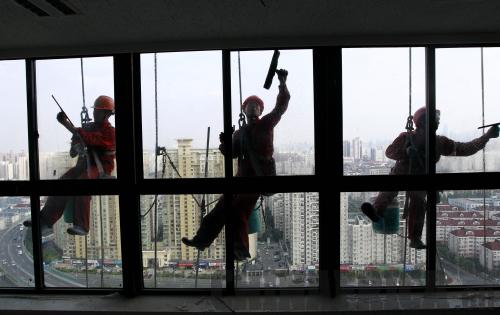|
 |
|
Divided Cities: Migrant workers often cannot establish residency in cities (PEI XIN) |
Is she a rural girl or city resident? Xu Shu doesn't know.
Xu works as a waitress at a small restaurant in the western part of Beijing. She is in her 20s, and moved to the capital from a village in Gansu Province.
In August, China announced that the country's urban population had officially surpassed 50 percent. But Xu can't say on which side of the 50-percent divide she stands. Leaving her rural hometown for years, Xu still feels like an "outsider" in the city of Beijing.
Global expectations of China are climbing; but the country is now facing a new, major domestic challenge: the further urbanization of the country, and more importantly, of its 230 million migrant population.
Urban explosion
On August 14, the Chinese Academy of Social Sciences (CASS) released The Urban Blue Book: China City Development Report No. 5. The report cites that urban dwellers now make up 51.27 percent of China's total population – a significant change in the country's social structure.
Xu and other new urban denizens like her, account for the increase but still can't see themselves as "urbanites."
"I don't have a Beijing hukou," she explains. "I will never be a Beijing resident." Her family's hukou booklet says what she is: a member of the "rural population of Gansu Province."
The hukou system, a household registration system unique to China, attaches a person to a particular place. People are registered in two categories: agricultural and non-agricultural. People with a non-agricultural hukou are far more likely to receive pensions, basic health care, and unemployment insurance under the social security system of the city.
Herein lies the biggest problem facing migrant population from rural areas. Simply moving to a city will not give them access to the social services available to someone with non-agricultural hukou.
Statistics show that endowment insurance, medical insurance and unemployment insurance in China are only accessible to 18.2 percent, 29.8 percent and 11.3 percent of all migrant workers across China, respectively.
Xu is in a relationship with a young man. He is from another village and also came to Beijing to seek work, but she's not confident about their future as a couple in Beijing since life will get tougher with every future milestone. Housing, medical bills, and education costs for children are all tied to hukou status. "In a few years, I might have to go back to my hometown to marry someone else," Xu says.
Beginning in the 1990s, China's farmers flooded into cities to meet the increasing demands of the country's industrialization boom. But even though their role in urban development has been crucial, migrant workers still feel there is a glass wall separating them from their city resident neighbors. Many migrants keep their land, believing that they will ultimately have to return to their fields. The land can remain idle for years, which in turn may affect national food supply.
"If the over 200 million migrant workers who aren't really urbanized are taken out of the equation, the real urbanization rate in China is only 36 percent," says Yang Weimin, Deputy Director of the Office of the Central Leading Group on Financial and Economic Affairs at an international seminar on housing policies on August 7.
Long Yongtu, former Vice Minister of Foreign Trade and Economic Cooperation (now Ministry of Commerce), elaborates on this gulf. "The biggest problem of China's urbanization," he says in a forum held in late August in Hebei Province, "is to find a way to turn migrant workers into real urban residents, providing them with equal access to social security, housing, medical care and public education."
Long believes that urbanization has to be slowed down if necessary in order to solve these problems.
|